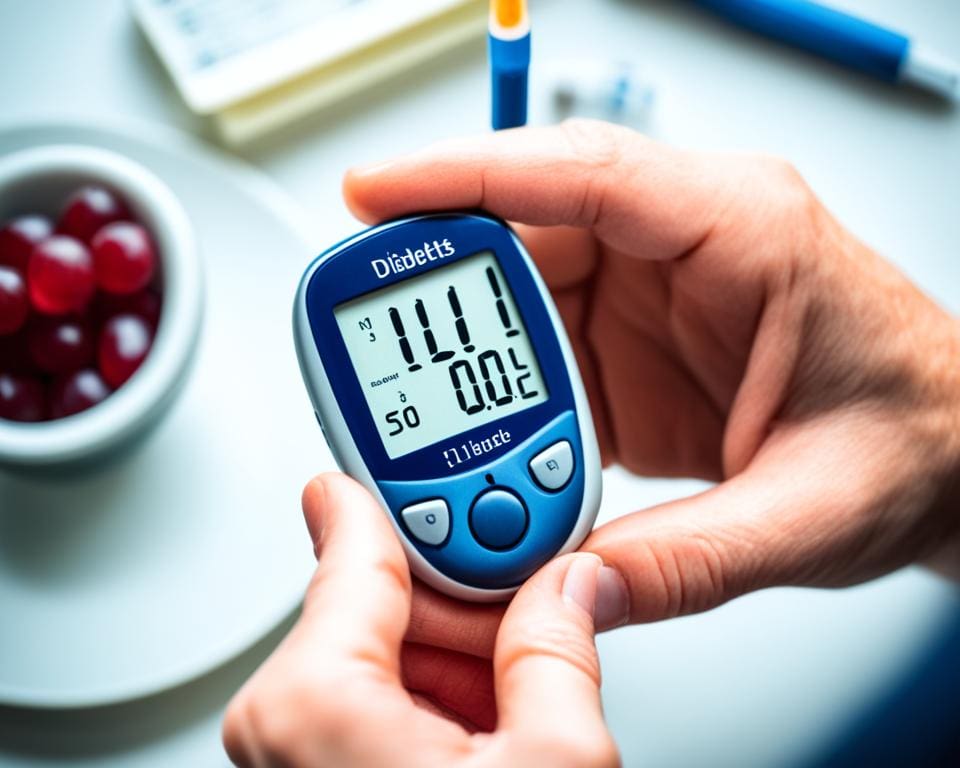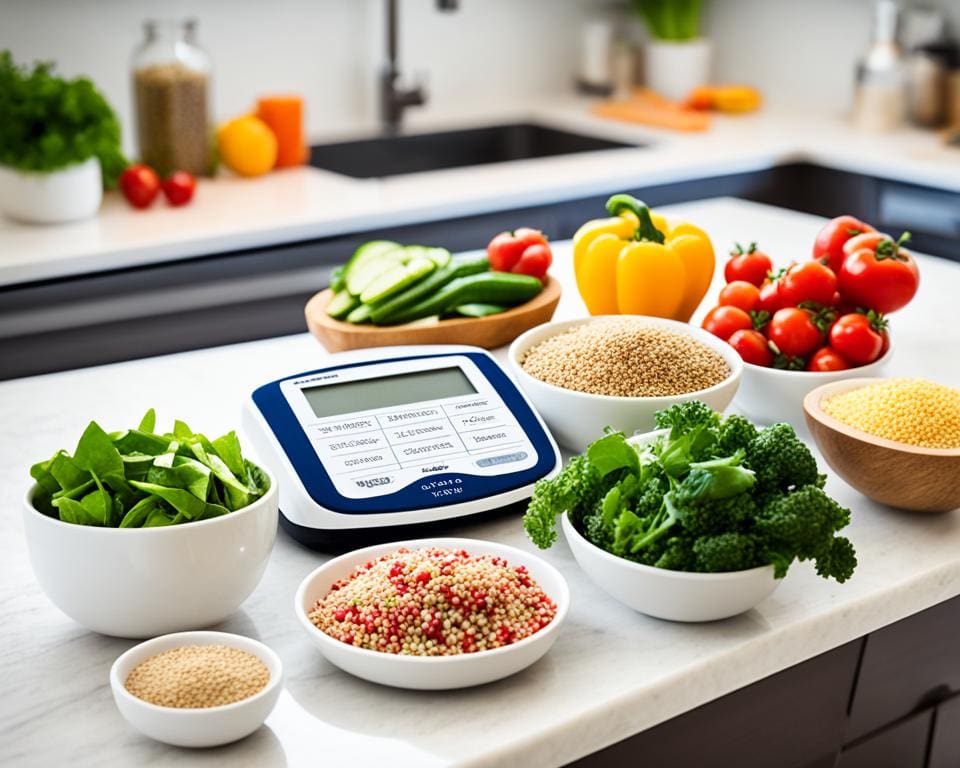If you have type 2 diabetes, you might wonder if supplements can help reverse diabetes or control your blood sugar better. Some research suggests certain supplements could help manage diabetes, but it’s important to know their limits and risks.
The American Diabetes Association says there’s no solid proof that herbal or nonherbal supplements help with diabetes unless you’re lacking something your body needs1. Also, supplements aren’t checked by the FDA, so you can’t be sure they’re safe or work as promised1.
Studies show that supplements like cinnamon, American ginseng, and others might lower blood sugar and make insulin work better in people with type 2 diabetes2. But remember, these results come from limited studies and shouldn’t replace proven diabetes treatments.
Some supplements, like aloe vera and cinnamon, might help lower blood sugar and improve diabetes markers3. But we need more research to be sure they’re safe and work well over time.
Before trying any supplements, talk to your doctor. They can tell you if they might affect your diabetes meds or cause side effects1. It’s better to eat a balanced diet full of whole foods instead of relying on supplements. Whole foods give you many nutrients that help your health together1.
Key Takeaways
- Supplements aren’t proven to reverse type 2 diabetes or control blood sugar.
- Some supplements, like cinnamon and aloe vera, might help, but we need more studies.
- Always talk to your doctor before taking supplements, as they could affect your diabetes meds.
- Eating a balanced diet with whole foods is better than relying on supplements for diabetes.
- While supplements can help, they shouldn’t replace proven treatments and lifestyle changes.
Understanding Type 2 Diabetes
Type 2 diabetes is a chronic condition that affects millions worldwide. It happens when the body’s cells don’t respond to insulin, a hormone that controls blood sugar. This makes the pancreas work harder to make more insulin, but it can’t keep up, leading to high blood sugar levels4.
What is Type 2 Diabetes?
Type 2 diabetes is a metabolic disorder with high blood sugar due to insulin resistance. When you eat, your body turns carbs into glucose, which goes into your bloodstream. Insulin helps cells use glucose for energy. But in type 2 diabetes, cells resist insulin, causing glucose to build up in the blood4.
Causes and Risk Factors
Several factors can increase your risk of type 2 diabetes, including:
- Being overweight or obese, especially if you carry fat in your abdomen4
- Not being active, as exercise helps control weight, use glucose, and improve insulin sensitivity4
- Family history of type 2 diabetes, showing a genetic link54
- Being part of certain ethnic groups, like Black, Hispanic, Native American, Asian, and Pacific Islander4
- Getting older, with the risk going up after 354
- Giving birth to a baby over 9 pounds or having gestational diabetes during pregnancy4
- Having polycystic ovary syndrome, linked to irregular periods, too much hair, and obesity4
Family history is a factor in type 2 diabetes, but lifestyle choices like diet and exercise matter a lot too5. Catching it early and acting fast is key to managing it well5.
Symptoms and Complications
Type 2 diabetes can cause symptoms like:
- Increased thirst and needing to pee more
- Blurred vision
- Slow-healing wounds
- Feeling tired
- Numbness or tingling in your hands or feet
If not treated, type 2 diabetes can lead to serious issues, such as:
- Heart and blood vessel disease
- Nerve damage (neuropathy)
- Kidney disease (nephropathy)
- Eye damage (retinopathy)
- Skin problems
- Hearing loss
- Sleep apnea
- Increased risk of dementia4
Starting healthy habits early can help prevent and reverse insulin resistance and prediabetes5.
Knowing about type 2 diabetes’s causes, risk factors, symptoms, and complications helps you take steps to prevent or manage it. Making lifestyle changes, like keeping a healthy weight, staying active, and eating well, can improve insulin sensitivity and lower blood sugar levels54.
Conventional Treatment Options for Type 2 Diabetes
Managing type 2 diabetes often means using medication and making lifestyle changes. These steps help control blood sugar and prevent serious health issues. The American Diabetes Association suggests screening for type 2 diabetes in adults over 35 and in certain high-risk groups6. A 1999 survey by the American Diabetes Association showed what treatments are commonly used for Type II diabetes7.

Medication
Medicines are key in treating diabetes, helping to lower blood sugar and make insulin work better. Metformin is usually the first choice for type 2 diabetes, but different medicines have their own risks and side effects6. Some people with type 2 diabetes might need insulin therapy if other treatments don’t work well enough6.
| Medication Class | Examples | Action |
|---|---|---|
| Biguanides | Metformin | Reduces glucose production in the liver and improves insulin sensitivity |
| Sulfonylureas | Glipizide, Glyburide | Stimulates the pancreas to produce more insulin |
| Thiazolidinediones | Pioglitazone, Rosiglitazone | Improves insulin sensitivity in muscle and fat cells |
| DPP-4 Inhibitors | Sitagliptin, Saxagliptin | Increases insulin production and decreases glucose production |
| GLP-1 Receptor Agonists | Exenatide, Liraglutide | Slows digestion, increases insulin production, and reduces glucose production |
Lifestyle Changes
Living a healthy lifestyle is crucial for managing blood sugar in type 2 diabetes. Important changes include:
- Diet: Eating a balanced diet low in calories and carbs helps manage blood sugar.
- Exercise: Regular activity, like 30 minutes of moderate exercise daily, boosts insulin sensitivity and controls blood sugar6. Adding resistance exercises 2 to 3 times a week is also beneficial for those with type 2 diabetes6.
- Weight management: Losing weight can improve blood sugar, cholesterol, triglycerides, and blood pressure, showing benefits after losing 5% of body weight6.
- Stress management: Lowering stress with techniques like meditation or yoga can help manage diabetes better.
The goal of treatment is to keep blood sugar levels within a healthy range to prevent complications.
Working with healthcare providers and using a full approach to diabetes treatment helps people with type 2 diabetes manage their condition. This approach includes both medication and lifestyle changes, improving overall health and well-being.
The Role of Diet in Managing Type 2 Diabetes
Diet is key in managing type 2 diabetes and keeping blood sugar levels in check. A well-planned diabetes diet helps you stay at a healthy weight, lowers the risk of complications, and boosts your health. Studies link dietary habits to the risk of getting type 2 diabetes8.

Low-Calorie Diets
Low-calorie diets, with 625-850 calories daily for 2-5 months, can help reverse diabetes and keep blood glucose close to normal for up to a year8. A study found that Mediterranean-style diets, often low in calories, improve blood sugar control, aid in weight loss, and cut down heart disease risk in type 2 diabetes patients8.
On a low-calorie diet, focus on foods packed with nutrients. Work with your healthcare team to plan meals that control your blood sugar9. A daily menu might include whole-wheat bread, jelly, shredded wheat cereal, low-fat milk, salmon, veggies, fruits, and popcorn9.
Low-Carbohydrate Diets
Low-carb diets focus on protein and healthy fats, helping to control blood sugar and improve insulin sensitivity. Research shows that low-carb diets are better at managing blood sugar in type 2 diabetes patients than other diets8.
A very low-carb ketogenic diet is more effective at controlling blood sugar and aiding weight loss in type 2 diabetes patients than recommended diets8.
On a low-carb diet, remember to:
- Choose healthy protein and fats
- Keep an eye on your carb intake
- Limit sodium to no more than 2,300 mg a day, or less if you have high blood pressure9
- Stay under 200 milligrams of cholesterol per day9
| Dietary Approach | Potential Benefits |
|---|---|
| Low-Calorie Diet | Improved glycemic control, weight loss, reduced cardiovascular risk factors |
| Low-Carbohydrate Diet | Improved glycemic control, weight loss, increased insulin sensitivity |
Diabetes increases the risk of heart disease and stroke by making arteries clog and harden faster9. A healthy diabetes diet can help manage your blood sugar and lower the risk of complications89.
Weight Loss and Its Impact on Type 2 Diabetes
Significant weight loss is key to diabetes reversal and better health for type 2 diabetes patients. The American Diabetes Association stresses the need to manage obesity to treat type 2 diabetes10. Studies reveal that losing a lot of weight can put type 2 diabetes into remission11.

The DiRECT Diabetes Remission Clinical Trial showed high remission rates in those who lost over 10 kg (about 22 pounds) and kept it off for 1 to 2 years11. Losing 10% or more of body weight made remission three times more likely than gaining weight12. This weight loss lowers fat in the liver and pancreas, helping beta cells work better. These cells are key for insulin release and controlling blood sugar levels.
Early weight loss can increase the chance of type 2 diabetes remission, but keeping it off is hard in real life12.
Key factors for remission include:
- Significant weight loss
- Good pancreatic function
- Short diabetes duration11
Weight loss can make the pancreas work better, leading to more insulin and type 2 diabetes remission11. Those with better pancreatic function and shorter diabetes duration are more likely to remit11. Doctors often push for big weight loss early on, rather than small changes and medication.
| Weight Loss Percentage | Reduction in Risk of Redeveloping Type 2 Diabetes |
|---|---|
| >10% | 48% |
| 5-9.99% | 22% |
| 10% |
The table shows how losing weight cuts the risk of getting type 2 diabetes again12. Losing more than 10% of body weight can cut the risk by 48%. Losing 5-9.99% or less than 4.9% can reduce the risk by 22% and 10%, respectively12. This underlines the importance of big weight loss for diabetes reversal and better insulin sensitivity.
Exercise and Physical Activity in Diabetes Management

Exercise is key in managing type 2 diabetes. It boosts insulin sensitivity, blood sugar control, and overall health. Regular workouts make your body use insulin better, which helps control blood sugar levels. In 2014, the National Diabetes Statistics Report highlighted the diabetes problem in the U.S13.. Yet, 34.3% of Americans with diabetes didn’t get enough exercise14.
Benefits of Regular Exercise
Regular physical activity is great for people with type 2 diabetes. A 2003 study showed that exercise improves heart health and lowers the risk of complications13. Another study in 2000 found that being unfit and inactive can increase the risk of death in men with type 2 diabetes13. A review of 20 studies found that being active can cut the risk of getting type 2 Diabetes by 42%14.
Recommended Types and Amounts of Exercise
The American Diabetes Association suggests 150 minutes of moderate or 75 minutes of vigorous activity weekly13. Research in 2009 showed that resistance training helps metabolic health in type 2 diabetes13. A 2002 study found that high-intensity resistance training improves blood sugar control in older adults with type 2 diabetes13.
A 2014 study compared different exercises for managing diabetes13. It found that combining aerobic and resistance exercises works best. A Nurses’ Health Study showed that walking more can lower diabetes risk by 34%14. The Henry Ford Exercise Testing Project found that being very active can cut diabetes risk by 54%14.
| Exercise Type | Recommended Duration | Frequency |
|---|---|---|
| Moderate-intensity aerobic activity | At least 150 minutes per week | Spread over at least 3 days |
| Vigorous aerobic activity | At least 75 minutes per week | Spread over at least 3 days |
| Resistance training | 2-3 sessions per week | Non-consecutive days |
Adding both aerobic and resistance exercises to your plan can help control blood sugar and improve health. A 2015 analysis looked at high-intensity interval training’s effects on glucose and insulin13. In 2017, a study showed that a specific type of training can boost insulin function in type 2 diabetes1314. Always talk to your doctor before starting any exercise program to make sure it’s right for you.
Bariatric Surgery as a Potential Treatment for Type 2 Diabetes
Bariatric surgery, like gastric bypass and sleeve gastrectomy, is a promising way to help people with type 2 diabetes who are also obese. These surgeries change the stomach and digestive system to reduce how much food you can eat. This leads to losing a lot of weight15. Being overweight often leads to type 2 diabetes15, and losing weight quickly through surgery can help manage this15.

Studies show that bariatric surgery can help control or even reverse type 2 diabetes. A review by Buchwald et al. in 2009 looked at how bariatric surgery affects weight and diabetes16. The study found that most patients saw their type 2 diabetes go into remission within 2 years, and they no longer needed medication1615. This shows that surgery can help manage blood sugar levels, making medication unnecessary15.
Research also shows that gastric bypass and sleeve gastrectomy are better at keeping weight off over time compared to gastric banding. A study compared laparoscopic sleeve gastrectomy (LSG) to laparoscopic Roux-en-Y Gastric Bypass (RYGB) for obese patients17. After 5 years, the average weight loss was 53.6% for LSG and 56.7% for RYGB17. Another study found that bariatric surgery leads to fewer long-term health problems and obesity-related issues than other treatments17.
Usually, people with a BMI of 35 or more can get weight-loss surgery15. But, surgery can also help those with type 2 diabetes and a BMI of 30 or more, especially if their diabetes is hard to manage15. It’s key to know that surgery works best for people with diabetes for 5 years or less and not on insulin.
More studies support the benefits of bariatric surgery for type 2 diabetes. Pories et al.’s 1995 study showed surgery is a top treatment for adult-onset diabetes16. A large study found that Roux-en-Y gastric bypass surgery greatly improved diabetes and reduced complications in type 2 diabetes patients17.
“Bariatric surgery has proven to be a game-changer for many individuals struggling with both obesity and type 2 diabetes. The ability to achieve significant weight loss and potentially reverse diabetes is truly remarkable.” – Dr. Sarah Thompson, Bariatric Surgeon
While bariatric surgery offers hope for diabetes reversal, it’s important to talk to a healthcare team before deciding. They will look at your health, how long you’ve had diabetes, and your treatment history to see if surgery is right for you.
Intermittent Fasting and Its Effects on Type 2 Diabetes
Intermittent fasting is a new way to help manage diabetes. It involves eating and fasting at different times. This can help improve insulin resistance and lead to weight loss.
Types of Intermittent Fasting
There are different ways to do intermittent fasting for type 2 diabetes:
- Time-restricted feeding: Eat only during a certain time each day, usually 8-12 hours.
- Alternate-day fasting: Fast one day and eat normally the next.
- 5:2 diet: Eat normally for five days and eat very little on the other two days.
Potential Benefits and Risks
Studies show that intermittent fasting can help people with type 2 diabetes. In one study, 90% of people took less diabetes medicine after trying it18. About 55% stopped taking diabetes medicine and kept it off for a year18.
Research found that 46% got better through eating less, and over 60% got better with lifestyle changes in three years19. In another study, 47.2% didn’t have diabetes after three months19. The fasting group lost more weight than the control group19.
At the end of a year, 16 people in the fasting group still didn’t have diabetes19. This was not true for the control group19.
Using intermittent fasting can also save money on medicine, as costs went down by 77%18. People in the fasting group felt better, while those in the control group felt worse19.
But, not everyone can do intermittent fasting. Those with more severe diabetes or on many medicines might need special advice from a doctor. Dr. Jesse Bakke says it’s important to get personalized advice, especially for those with advanced diabetes19.
Around 45% of people in the early stages of type 2 diabetes who lose weight rapidly can reverse diabetes. – Dr. Courtney Peterson19
Intermittent fasting looks promising for type 2 diabetes. But, it’s important to talk to your doctor to see if it’s right for you and how to do it safely.
Natural Therapies for Stress Management in Diabetes
Stress can really affect your blood sugar levels, making it key to managing diabetes. In 2011, 25.8 million people in the U.S. had diabetes20. Besides traditional treatments, using natural ways to relax can help control blood sugar and improve health.
Deep abdominal breathing is a simple way to lower stress. It involves taking slow, deep breaths from the diaphragm, which helps your body relax. Another method is progressive muscle relaxation. This means tensing and relaxing different muscle groups to feel calm.
Guided imagery and visualization can also help with stress. Imagine yourself in a peaceful place or picture a good outcome to reduce stress. Biofeedback, which lets you control your body’s functions like heart rate, can also help manage diabetes-related stress21.
“Stress management is a crucial aspect of diabetes care. By incorporating natural therapies alongside conventional treatment, individuals with diabetes can better manage their blood sugar levels and improve their quality of life.” – Dr. Sarah Thompson, Endocrinologist
Remember, natural therapies should not replace your regular diabetes care. They should be used with your medication, lifestyle changes, and doctor visits. Studies show that exercise can cut the risk of type 2 diabetes by 30-50%22. Adding exercise to your stress management can also bring more benefits.
| Natural Therapy | Benefits |
|---|---|
| Deep Abdominal Breathing | Activates the body’s relaxation response |
| Progressive Muscle Relaxation | Promotes a sense of calm throughout the body |
| Guided Imagery | Reduces stress and enhances overall well-being |
| Biofeedback | Helps monitor and control physiological functions related to stress |
Using a mix of natural therapies and traditional treatments can help manage stress and support diabetes care. Remember, the best way to control blood sugar involves taking care of both your body and mind.
Supplements and Their Role in Diabetes Management
Many people with diabetes use diabetes supplements to help control their blood sugar and improve health. But, it’s important to know that supplements aren’t checked by the FDA like medicines are. They might not always be safe or work well. Some supplements might help with diabetes, but talk to your doctor first to make sure they’re safe with your other medicines.
Common Supplements Marketed for Diabetes
Some supplements are popular for helping with diabetes. These include:
- Cinnamon
- Chromium
- Magnesium
- Omega-3 fatty acids
- Alpha-lipoic acid
- Bitter melon
- Gymnema sylvestre
Some studies suggest these supplements could be helpful for diabetes. For example, chromium might help with glucose tolerance in some people23. Coenzyme Q10 might also lower blood sugar levels23.
But, the American Diabetes Association says there’s no clear proof that most supplements help without a lack of certain nutrients. Some plants might help with diabetes, but we need more research24.
Potential Interactions with Diabetes Medications
Using supplements for diabetes can be risky because they might not work well with your medicines. This could lead to serious problems like low or high blood sugar.
For example, magnesium can help some type 2 diabetics manage their blood sugar, possibly reducing the need for insulin23. But, taking magnesium with some diabetes medicines could lower your blood sugar too much.
Similarly, vanadium and vitamin E might help with blood sugar levels, but they could also affect how well your diabetes medicines work23.
Before adding supplements to your diabetes care plan, talk to your doctor. They can help you understand the risks and benefits. This way, you can choose supplements that are safe and right for you.
The Importance of Working with Your Healthcare Team
Managing diabetes well needs teamwork between you and your healthcare team. Your primary care provider (PCP) is key, overseeing your care, checkups, and prescribing medicines25. Endocrinologists are also crucial, focusing on diabetes and hormone issues25.
Other team members include diabetes care specialists who give you personalized advice and support25. Dietitians help you eat right, manage your blood sugar, and prevent complications25.
Regular checks are vital, and your team helps with this. Eye doctors look after your eyes, and podiatrists protect your feet25. Audiologists check your hearing, dentists your mouth, and nephrologists your kidneys25.
Pharmacists talk about your meds and how they affect your blood sugar25. Mental health experts and exercise specialists also play big roles25.
Working together in healthcare can really improve health outcomes26. Doctors and nurses working together can make a big difference26.
Studies show team-based care lowers blood sugar levels and improves health markers27. It helps more patients meet health goals set by experts27.
Working with your healthcare team and talking openly is key to managing diabetes well. Regular check-ups and sticking to your plan can greatly improve your health.
| Healthcare Team Member | Role in Diabetes Management |
|---|---|
| Primary Care Provider (PCP) | Routine medical care, checkups, exams, lab tests, prescribing medications |
| Endocrinologist | Specialist in treating hormone problems, including diabetes |
| Diabetes Care and Education Specialist | Provides personalized diabetes self-management education and support |
| Registered Dietitian | Helps develop healthy eating patterns for blood sugar management and overall health |
| Eye Doctor (Ophthalmologist/Optometrist) | Monitors and treats diabetes-related eye conditions |
| Podiatrist | Cares for feet and lower legs, protecting against infection risks |
| Audiologist | Specializes in hearing and balance issues, recommends early hearing tests |
| Pharmacist | Provides information on medications, advises on interactions and usage |
| Dentist | Manages oral health, important for diabetes patients at higher risk of gum disease |
| Nephrologist | Specializes in kidney care, necessary due to potential damage from diabetes |
| Mental Health Professional | Helps manage daily diabetes care and mental health issues |
| Exercise Specialist (Physical Therapist/Personal Trainer) | Contributes to structured physical activity plans for diabetes management |
Can You Reverse Diabetes?
There is no permanent cure for type 2 diabetes, but you can put it into remission with big weight loss and lifestyle changes28. Remission means your blood sugar stays healthy without needing medicine, effectively turning the disease around28. But, it’s important to know that type 2 diabetes can get worse over time. You’ll need to keep managing it and might need to change your treatment28.
How well you can reverse diabetes depends on how long you’ve had it, if you need insulin, and how much weight you lose28. Losing 5-7% of your body weight can stop or slow down diabetes29. If you’re overweight and lose 5% of your weight, you might see better blood sugar control and need less medicine28.
Changing your lifestyle, like eating better and moving more, is key to managing and possibly reversing type 2 diabetes30. The CDC says adults should do at least 150 minutes of moderate exercise each week to manage diabetes well28. Trying for 30 minutes of activity 5 days a week can help meet this goal29.
Experts say diabetes remission is when your A1c levels are below 48 mmol/mol or less than 6.5% after stopping medicine for 3 months28.
Some people can reverse type 2 diabetes with just lifestyle changes, but others might need medicine or insulin30. It’s important to work with your healthcare team to make a plan that works for you to manage diabetes and possibly go into remission.
Stories suggest you can stay in remission from type 2 diabetes for up to 15 years, but remember it’s a chronic condition that needs ongoing care28. Keeping a healthy lifestyle with good food, regular exercise, and taking your medicine can help manage the disease and prevent problems28.
Emerging Research on Diabetes Reversal
Researchers are looking into new ways to treat type 2 diabetes, hoping to reverse it. They’re focusing on making or replacing insulin-producing cells in the pancreas. These treatments are still being tested and aren’t yet available to everyone.
Stem Cell Therapy
Stem cell therapy is a new hope for diabetes. It uses stem cells to make new insulin-producing cells in the pancreas. Early tests look promising, but we need more research to be sure it works.
Islet Cell Transplantation
Islet cell transplantation is another new way to treat diabetes. It moves insulin-producing cells from one pancreas to someone with diabetes. This can help control blood sugar and reduce insulin needs. But, it requires taking drugs to prevent rejection, which can have side effects.
Pancreas Transplantation
Pancreas transplantation is for people with type 1 diabetes and kidney failure. It puts a healthy pancreas from a donor into the person. This can cure diabetes. But, it’s a big surgery and only for those with severe diabetes problems.
| Therapy | Description | Current Status |
|---|---|---|
| Stem Cell Therapy | Regenerating insulin-producing beta cells using stem cells | Promising animal studies and small human trials; more research needed |
| Islet Cell Transplantation | Transplanting insulin-producing islet cells from a donor pancreas | Can help restore blood sugar control; requires immunosuppressive drugs; not widely available |
| Pancreas Transplantation | Transplanting a healthy pancreas from a deceased donor | Potential treatment for type 1 diabetes with severe complications; requires lifelong immunosuppressive drugs |
These new treatments are promising but not yet proven cures for diabetes. Losing about 15kg is key for most people with type 2 diabetes31. Those with type 2 diabetes should try to lose 10% of their weight31. Eating whole foods, cutting carbs, and eating more protein and fat can help reverse Type 2 diabetes32. Cutting carbs is safe and can also improve health beyond diabetes management32.
As research goes on, people with type 2 diabetes should work with their doctors. They should focus on a healthy diet, exercise, and the right treatments or medications.
Conclusion
Managing type 2 diabetes means making many changes in your life, using medicines, and keeping an eye on your health. Supplements might look like an easy fix, but they shouldn’t take the place of proven treatments. They could also affect your medicines in bad ways33. The best ways to handle diabetes include losing weight, eating right, staying active, and working with your healthcare team3334.
New treatments like stem cell therapy, islet cell transplantation, and pancreas transplantation might help reverse diabetes one day. But, we need more studies to make sure they’re safe and work well33. If you have type 2 diabetes, it’s key to work with your healthcare team to find a plan that fits your needs and goals.
Handling type 2 diabetes is a long-term job that needs your full commitment. By making smart health choices, staying in touch with your healthcare team, and living a healthy life, you can manage your diabetes well. This can lower your risk of problems. Even if you can’t fully reverse it, controlling your blood sugar can make you healthier and improve your life a lot.
FAQ
Can supplements reverse type 2 diabetes?
Supplements aren’t proven to lower blood sugar or help manage diabetes, says the American Diabetes Association. They don’t help if you’re not lacking in certain nutrients. They can also cause bad side effects, especially if they mix with diabetes drugs.
What causes type 2 diabetes?
Type 2 diabetes comes from obesity, not moving enough, and genes. It makes cells that control blood sugar not work right. This leads to insulin resistance and high blood sugar.
What are the symptoms of type 2 diabetes?
Symptoms include feeling thirsty, peeing a lot, blurry vision, and slow healing of wounds. But, some people with type 2 diabetes might not show any symptoms at first.
What are the complications of type 2 diabetes?
Complications include heart disease, stroke, kidney disease, nerve damage, and eye damage. Keeping blood sugar in check can prevent or delay these issues.
What medications are used to treat type 2 diabetes?
Treatments include insulin, metformin, sulfonylureas, and other drugs that lower blood sugar. The right treatment plan depends on your health and should be talked over with a doctor.
Can lifestyle changes help manage type 2 diabetes?
Yes, eating right, moving more, and managing stress can help manage type 2 diabetes. These changes should be part of a plan made with your healthcare team.
What diet is best for managing type 2 diabetes?
Low-calorie and low-carb diets can help control blood sugar and improve insulin sensitivity. But, the best diet plan depends on you and should be made with a healthcare provider or dietitian.
Can weight loss reverse type 2 diabetes?
Losing a lot of weight can help reverse type 2 diabetes in some people. It makes the liver and pancreas less fatty, helping insulin work better. The best time to reverse diabetes is early after diagnosis.
How much exercise is recommended for people with type 2 diabetes?
Aim for 150 minutes of moderate activity or 75 minutes of hard activity each week. Spread it out over three days with no more than two days off. Exercise helps control blood sugar and lowers the risk of complications.
Is bariatric surgery an option for treating type 2 diabetes?
Yes, surgeries like gastric bypass can treat type 2 diabetes in the obese. They help with weight loss by changing the stomach and digestive system. Surgery is an option for those with a BMI of 35 or more and diabetes.
Can intermittent fasting help reverse type 2 diabetes?
Some studies show that fasting can improve blood sugar control and insulin sensitivity. But, more research is needed to understand its long-term effects. Always talk to a healthcare provider before starting fasting.
Can stress affect blood sugar levels in people with type 2 diabetes?
Yes, stress can change blood sugar levels in people with diabetes. Stress management techniques like deep breathing and relaxation can help. Always use these with your regular diabetes care plan.
Are supplements safe for people with type 2 diabetes?
Many diabetes supplements aren’t FDA-approved and may not be safe or work well. They can also interact badly with diabetes drugs, causing blood sugar problems. Always check with your doctor before taking any supplements.
Why is it important to work closely with a healthcare team when managing type 2 diabetes?
A healthcare team helps manage diabetes with the right treatment plan. They include doctors, educators, and nutritionists. Regular check-ups and talking with your team can keep you on track and prevent complications.
Can type 2 diabetes be reversed?
There’s no cure for type 2 diabetes, but some people can reverse it with weight loss and lifestyle changes. Remission means you don’t need medication anymore. But, diabetes is a lifelong condition and symptoms might come back. Working with a healthcare team and making lasting lifestyle changes are key.
What new therapies are being researched for type 2 diabetes reversal?
Researchers are looking into new therapies like stem cell and islet cell transplants. These could help make more insulin in the pancreas. But, these are not yet widely available and are not considered cures for diabetes.
Source Links
- https://diabetes.org/food-nutrition/diabetes-vitamins-supplements
- https://www.healthline.com/nutrition/blood-sugar-supplements
- https://www.medicalnewstoday.com/articles/317051
- https://www.mayoclinic.org/diseases-conditions/type-2-diabetes/symptoms-causes/syc-20351193
- https://www.nebraskamed.com/diabetes/is-it-possible-to-reverse-diabetes
- https://www.mayoclinic.org/diseases-conditions/type-2-diabetes/diagnosis-treatment/drc-20351199
- https://www.ncbi.nlm.nih.gov/pmc/articles/PMC3249697/
- https://www.ncbi.nlm.nih.gov/pmc/articles/PMC10649708/
- https://www.mayoclinic.org/diseases-conditions/diabetes/in-depth/diabetes-diet/art-20044295
- https://www.ncbi.nlm.nih.gov/pmc/articles/PMC9284579/
- https://www.niddk.nih.gov/health-information/professionals/diabetes-discoveries-practice/achieving-type-2-diabetes-remission-through-weight-loss
- https://www.medicalnewstoday.com/articles/weight-loss-rarely-leads-to-type-2-diabetes-remission-in-real-world-settings
- https://www.ncbi.nlm.nih.gov/pmc/articles/PMC5846677/
- https://www.ncbi.nlm.nih.gov/books/NBK549946/
- https://www.templehealth.org/about/blog/how-bariatric-surgery-can-reverse-type-2-diabetes
- https://www.ncbi.nlm.nih.gov/pmc/articles/PMC3102524/
- https://www.ncbi.nlm.nih.gov/pmc/articles/PMC7522929/
- https://www.endocrine.org/news-and-advocacy/news-room/2022/intermittent-fasting-may-reverse-type-2-diabetes
- https://www.medicalnewstoday.com/articles/type-2-diabetes-intermittent-fasting-could-reverse-the-condition
- https://www.todaysdietitian.com/newarchives/111412p28.shtml
- https://www.urmc.rochester.edu/encyclopedia/content.aspx?ContentTypeID=134&ContentID=166
- https://www.rupahealth.com/post/integrative-medicine-protocol-for-reversing-type-2-diabetes
- https://www.diabetes.co.uk/vitamins-supplements.html
- https://www.ncbi.nlm.nih.gov/pmc/articles/PMC10218826/
- https://www.cdc.gov/diabetes/treatment/diabetes-doctors.html
- https://www.ncbi.nlm.nih.gov/pmc/articles/PMC7054922/
- https://www.ncbi.nlm.nih.gov/pmc/articles/PMC7373227/
- https://www.healthline.com/health/type-2-diabetes-reversible
- https://www.emoryhealthcare.org/stories/wellness/5-ways-to-reduce-or-even-reverse-diabetes
- https://www.nnmc.com/about/blog/can-you-reverse-type-2-diabetes
- https://www.ncl.ac.uk/magres/research/diabetes/reversal/
- https://www.aut.ac.nz/news/stories/new-research-on-reversing-type-2-diabetes
- https://www.ncbi.nlm.nih.gov/pmc/articles/PMC6520897/
- https://www.ncbi.nlm.nih.gov/pmc/articles/PMC9206440/





















































